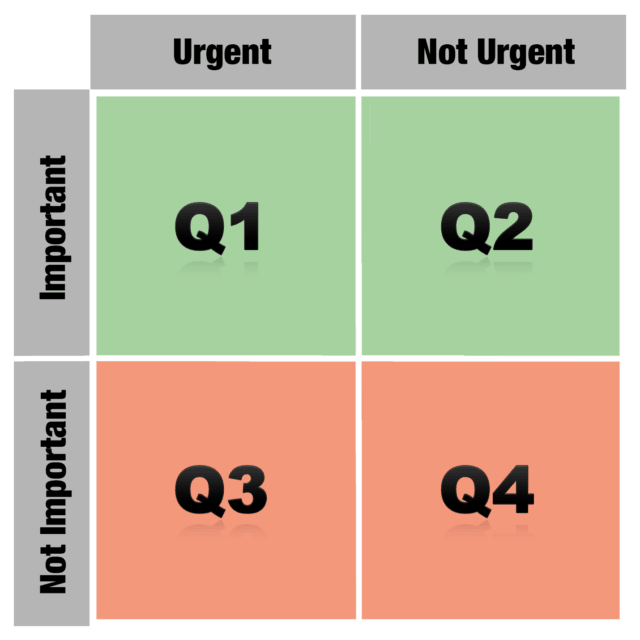
Productive people are motivated to get things done. Checking an item off your to-do list is very rewarding. There is a sense of accomplishment when you finish the task, meet the deadline, or achieve the goal. Finishing important tasks feels great!
However, some days it seems impossible. You open your task manager and there is an immediate sense of overwhelm because it is more than anyone could do in one day. What if it did not have to be that way? What if there was a way to finish your to-do list every single day?
How you start has a lot to do with how you finish. If you start the day with clarity and focus, then you can end the day feeling successful and productive. You might think, how does clarity and focus help me finish everything on my never-ending to-do list? The question reveals the problem. Most people have a “never-ending” to-do list. Productive people don’t do everything. They do the most important things.
Prioritize Tasks

Not all tasks are created equal. Some tasks are more important than others and represent a better use of your time. Learning to see the difference is a skill that everyone can learn to maximize their productivity. A very practical way to implement this principle is to use it to transform your to-do list into a productivity secret weapon.

Your to-do list can be either a mountain that is so high you cannot see the summit, or it can be a step ladder that helps you easily reach a new level of productivity. The difference between the two is learning how to prioritize tasks. A well-organized to-do list helps you recognize what is important compared to what is urgent or a distraction. Some things should be delegated, and some things should be eliminated.
Plan Your Schedule During Your Morning Ritual
Today you are going to learn a simple framework called a time management matrix that will help you evaluate what is on your to-do list and prioritize tasks. This is something you can do each day as a part of your morning ritual. All you need to get started is a sheet of paper.
A Typical To-do List When You Don’t Prioritize Tasks

Let’s consider a real-world example of how this works. Imagine you are working for the loan department of a large bank. The market has recovered and the amount of loans you are processing has doubled. Business is great, and you are excited because you are helping people live their dream of owning a home.
You earn a good salary, but you want to get more out of life. Not only do you want to move up at the company, but you also want to spend more time with your family and maybe even start a business on the side.
As you walk into your office, you grab a cup of matcha tea (what every AE aficionado should have of course) and you’re about to review what you’re going to do that day. This is what your todo list looks like (in no particular order):
- Call client Marissa re: mortgage options
- Re-arrange my schedule to be at Johnny’s soccer games
- Weekly company meeting on IT and Infrastructure
- Watch the big game after work with friends
- Show my new assistant Kathy how to research and book flights for my travel
- Update social media of my company account
- Upload photos of my recent vacation with the wife on Facebook
- Research options for coaching on my productivity
- Put a proposal together for client Joe
- Catch up on the most recent episodes of the Walking Dead
A typical to-do list, right? It’s a mix of stuff you have to get done at work but also a few actions you have to do at home. At this point, you might feel overwhelmed. Everything looks important, and you’re not sure how to prioritize tasks. What is the best way to spend your time? Where should you start?
Set Goals and Priorities

To be able to prioritize, you have to know what your goals are. When you have no goals, you cannot prioritize your to-do list. Let me repeat that one more time: to be able to prioritize tasks, you have to know what your goals are.
You Need Clear Goals
I purposely didn’t tell you the goals in this example to illustrate the point that it’s impossible to prioritize your to-do list. So let’s just say you have a goal for yourself on a company level and for your personal life:
- Work goal: Sell 5 mortgages in quarter 3
- Personal goal: watch every soccer game of little Johnny every Saturday morning for Q4 and beyond
Now that you know what your goals are, can you see how it’s a little easier to prioritize?
If a task is not related to any of your goals, it should be ranked at the bottom of your list. So let’s prioritize everything based on what we know now:
- Call client Marissa re: mortgage options
- Put a proposal together for client Joe
- Re-arrange my schedule to be at Johnny’s soccer games
- Show my new assistant Kathy how to research and book flights for my travel
- Weekly Company meeting on IT and Infrastructure
- Research options for coaching on my productivity
- Update social media of my company account
- Watch the big game after work with friends
- Upload photos of my recent vacation with the wife on Facebook
- Catch up on the most recent episodes of the Walking Dead
This is looking much better now, doesn’t it? You have a better sense now of what you should do, in what order. At this point, you’re already ahead of what most people know and do. But there’s one more problem. What’s the EXACT order you’re going to get things done?
You Need to Prioritize Tasks
What do you do first? What do you do second?
This is critical to maximize the value of your time. It would be a waste of time to work on something that’s maybe ranked fifth on your list as your frog for the day (your most important task). By the time you finish your fifth priority, you might not have the time, energy, and focus to work on what’s actually the first priority on your list. That’s when you’ll put it off, procrastinate on it, and move it to another day. What a waste!
The Problem with Working on Your Most Important Tasks Later in the Day

Our days can be very unpredictable so it’s best to always work on your most important task first before anything else. This principle is known as Eating Your Frog (an idea we picked up from Brian Tracy) and it’s one of the first things we teach every new AE client.
Why? The order of what you do matters. There must be a priority to your to-do list. You cannot work on task #2 until task #1 is done. Once task #1 is done, only then are you allowed to move on to task #2 (not to task #5 or #6 – no matter how fun or easy they appear).
Ideally, you want to start with your frog – one task that is your highest priority – first. Even if you get sidetracked at some point, you can go home knowing you’ve completed your top priority. The reason a lot of people feel stressed is that they don’t work on their tasks in order. hey either leave their priorities till the last minute (yikes!) or they have to bring work home and finish it off then (not ideal either).
Sound familiar?
I have to admit, after working with many clients and having it done myself, working on your tasks in order is not easy. It requires discipline. The good news is that everyone can develop this type of discipline.
So how do you prioritize tasks? This is where the Q2 Matrix comes in.
The Q2 Matrix is the Key to Prioritize Projects, Tasks, and Responsibilities
If you’ve read the 7 Habits of Highly Effective People, this quadrant might look familiar:
It is a time management system. It used to be called the Covey Quadrant, aptly named after Stephen Covey who wrote the book. Some people call it the Eisenhower Matrix popularized by president Eisenhower. It is a method to evaluate priorities and get things done in the most efficient way possible.
Prioritizing Based on Urgency and Importance
Here’s how it works: every item on your to-do list fits in one of the quadrants (Q1, Q2, Q3, Q4).
Q1 – The Quadrant of Necessity. These tasks are important and urgent. These must be done to do your work and live your life. They don’t necessarily move you forward that much towards your goals, but not doing them would set you back. Typical tasks are deadline-driven, time-sensitive, and part of day-to-day work and living.
Q2 – The Quadrant of Extraordinary Productivity. Your tasks are important but not urgent. This is where you choose what you want to work on because it gives you the highest return on your time and the tasks bring you closer to your goals. Typical tasks here are relaxation, planning, executing tasks in alignment with your goals, building relationships, and thinking time.
Q3 – The Quadrant of Distraction. The tasks that fall in this quadrant are typically not important but feel urgent. I have emphasized the words “feel urgent” because this is where most people confuse what belongs in Q1 but actually do not. Typical tasks would be anything not in alignment with your goals but you somehow feel that they need to be done (false Quadrant 1 tasks). For example, attending meetings that aren’t really that important for what you do.
Q4 – The Quadrant of Waste. Everything here is not important and not urgent. Any tasks in this quadrant should be avoided and not done in excess. What’s interesting about this quadrant is that some activities here can belong in Q2 because they help you relax, rejuvenate, and build relationships with people. However, when done too much it’s a waste of time. Watching TV can help you relax (Q2) but done in excess is a waste of time (Q4). I love playing board games with friends (Q2) but when I go overboard for a whole evening with lots of fast food and alcoholic beverages, it becomes a Q4 activity.
How to Get Things Done Using the Priority Matrix
Now that you understand how the prioritization system works, here’s what you should aim for:
- Maximize the number of activities you do in the second Quadrant (Extraordinary Productivity).
- Minimize the Quadrant 1 activities to the bare necessities.
- Avoid anything in the bottom half of the quadrant.
Create a List Based on Priorities
Sounds simple, right? So let’s go back to our earlier example and now put every todo list item in one of the quadrants:
Q1 (Quadrant of Necessity):
- Call client Marissa re: mortgage options
- Put a proposal together for client Joe
Q2 (Quadrant of Extraordinary Productivity):
- Re-arrange my schedule to be at Johnny’s soccer games
- Show my new assistant Kathy how to research and book flights for my travel
- Research options for coaching on my productivity
Q3 (Quadrant of Distraction):
- Weekly Company meeting on IT and Infrastructure
- Update social media of my company account
- Catch up on the most recent episodes of the Walking Dead
Q4 (Quadrant of Waste):
- Watch the big game after work with friends
- Upload photos of my recent vacation with the wife on Facebook
Now that we have all ten tasks in one of the quadrants, can you see how it is a much better system to prioritize now and free up hours in your week?
A List You Can Complete
If we follow the guidelines I mentioned earlier, then we want to maximize the number of tasks that are in Q2 (Quadrant of Extraordinary Productivity) and then do the activities that are in Q1 (Quadrant of Necessity). This is how your todo list would look like:
- Re-arrange my schedule and work hours for Johnny’s soccer games
- Call client Marissa re: mortgage options
- Put a proposal together for client Joe
Wow, what a difference! It only has 3 things on there, in order. Isn’t this much easier to do and complete?
At AE, we’re big proponents of having only 3 things on your to-do list for the day. This forces you to prioritize and maximize the use of your time.
That doesn’t mean we’re ignoring the other things we need to do. If we finish early, we can always add more things to do. But…you know you had an Asian Efficient day if you finished all 3 items on your to-do list. You can go home and sleep knowing you made significant progress.
Note: Notice how I didn’t put all Q2 tasks on the to-do list. There’s a reason for this and I’ll cover this in a moment.
The Value of Quadrant 1 and 2

Ideal or Realistic
There is a difference between what is ideal and realistic. The time management matrix is a tool that everyone can use to transform your t0do list into something that works in your real life.
In a fantasy world, you would do everything in Quadrant 2 (Extraordinary Productivity) before you ever get to Quadrant 1 (Necessity) activities.
In reality, that doesn’t work for most people. Especially when it’s the first time you implement this priority system. What we typically see is that people never get to their Quadrant 2 activities at all. They logically know that they must do them, but they get distracted from everything they need to do in Quadrant 1 (Necessity) and Quadrant 3 (Distraction). In some cases, they might also do too much of the activities in Quadrant 4 (Waste).
Put Everything in the System
The first step is for you to be aware of where all your activities and tasks belong. Only then can you proactively work on getting your tasks in order of importance.
We usually recommend that you slot in only one task from Quadrant 2 (Extraordinary Productivity) and make that your frog. Get it out of the way first thing in the day and then you have the rest of the day for everything else which are ideally Quadrant 1 (Necessity) tasks. Notice how I did that with the last todo list:
- Re-arrange my schedule to be at Johnny’s soccer games (Q2 – important and not urgent)
- Call client Marissa re: mortgage options (Q1 – important and urgent)
- Put a proposal together for client Joe (Q1 – important and urgent)
I re-arranged the to-do list so you would start with a Quadrant 2 task (your frog) and let the rest of your day fill in the gaps of what you need to do to achieve your goal of closing 5 mortgages in one quarter.
In this example, your personal goal is to be able to attend every soccer game of your kid and that requires thinking, planning, and execution to make that happen. This is not an easy feat and it might happen over a period of a few weeks, but once you have it figured out, you would be ecstatic, right? That’s why I put it in Q2 and not in Q1.
Quadrant 3 (Distraction)
![]()
The most interesting Quadrant, in my opinion, is Q3 (Distraction). This is where people will often confuse tasks and activities as important (Q1) but in reality, they are not. As a result, they spend too much time in Quadrant 3. Let’s look at what we had in Q3 (Distraction):
- Weekly Company meeting on IT and Infrastructure
- Update social media of my company account
- Catch up on the most recent episodes of the Walking Dead
When you have uncertainty about your goals, everything will feel important and urgent. In this case, attending a company meeting and updating your business social media accounts might feel important. In our example, it’s not. As a loan officer, do you really need to attend an IT and Infrastructure meeting every week? It might feel important to be aware of what’s going on, but is it really important?
In your personal life, do you really need to watch that particular TV show? Is it really that important to you? It feels urgent (tv shows are time-sensitive) and important to you when you have no goals. I can’t repeat this enough: when you don’t have a clear picture of your goals, everything will feel important and urgent. Prioritizing with the Q2 Matrix gives you a method to focus on what really matters.
Quadrant 4: Identify What Could Break your Focus or Steal Your Energy

Finally, let’s look at what we had in the last quadrant.
Q4 (Quadrant of Waste):
- Watch the big game after work with friends
- Upload photos of my recent vacation with the wife on Facebook
Out of all the things on your to-do list, these are the things you want to avoid. Out of all the things on your to-do list, these are the things you want to avoid. They are not priorities in alignment with your goals. If anything, they move you away from your goals. This kind of clarity is one of the huge benefits of using this system.
This is a tough reality we all need to be reminded of: if you want to achieve your goals, you have to be willing to give up things to achieve them. Every goal comes with a price – some more than others. A lot of these things fall in this quadrant.
Just like with Q3 (Distraction), when you put your to-do list together in this Q2 Matrix, you must have at least one item in Q4. If you don’t, you’re confusing what’s important and what’s not. You might also not be willing to give up certain things to accomplish your goal which to me is a red flag. But let’s assume you have a couple of things on there.
Does that mean you cannot do them at all?
The big idea is to do Q4 activities in moderation. I love playing video games and board games. In my current life situation, it would be considered a Q4 activity. Does that mean I will never play them? Of course not. That would be ridiculous. I am conscious that it should be done in moderation and if I do it excessively, I have to be okay with the fact that it’s slowing me down from achieving my goals.
So don’t try to be perfect. No one is. With a little control, you can enjoy your life but at least be aware of which activities and tasks might slow you down.
Prioritize for Long-Term Success
Over time, you want to live in the upper half of the quadrants (Q1 and Q2) and it becomes a fun game. How can you add more Q2 (Extraordinary Productivity) in your daily life and minimize the number of activities in Q1 (Necessity).
This is a lifelong journey.
As you’re climbing the ladder and growing, you have to frequently re-evaluate where your tasks and activities belong. The faster the growth, the more often you need to do this.
The Difference Between Activities and Important Tasks

Before we move to the next actions, one thing I’d like for you to be aware of is the difference in activities and tasks. In the Covey book, you see examples of major life activities that are being divided. For example, “planning” and “relaxing” are major activities that you could easily slot in Quadrant 2 (Extraordinary Productivity). Just like “filing taxes” is easily slotted in Quadrant 1 (Necessity).
While we recommend you slot major life activities in the four quadrants, on a practical level you want to do this for your tasks too. It’s good to know on a high level what you should and shouldn’t be doing.
When we zoom in on the task level, we want to be efficient. Ranking your tasks with the quadrants will give you a clear picture of your priorities and help you focus on how to use your time efficiently.
Next Actions – Helpful Tips to Create Your Own Time Management Matrix
Now that you understand how you can prioritize your todo list, here’s what we recommend you do next:
Five Tips For Prioritizing Your Todo List
- Recreate the matrix on a sheet of paper.
- Take your todo list and put all tasks in one of the quadrants
- Once it’s all slotted, put one Q2 (Extraordinary Productivity) at the top of your new to-do list.
- Fill the rest of the to-do list with everything you have in Q1 (Necessity).
- Eat your frog with the first task on your list and do not move to the second task until the first task is done.
With the help of the time management matrix, you have now successfully prioritized your to-do list. Doesn’t it feel amazing? Prioritizing helps you free up time to do the work that matters the most.
Take Control of Your Efficiency
For more actionable productivity materials, we recommend you check out the Dojo – our private training library with a community of people who are passionate about productivity. You can see examples of how others (like you) have successfully used this system to set priorities, and we have more materials that will help you achieve your goals faster (including the apps and tools you can use to implement this).


Great article. Both inspiring and actionable!
Question: Why is “Re-arrange my schedule and work hours for Johnny’s soccer games” put in Q2 instead of Q1?
I was looking for the Eisenhower matrix but came across this article instead. It’s much more useful! Thank you for your clear explanation on how some tasks look important but are not in actuality. My weekly review is easier now I have a better grasp on how to organize and prioritize according to my goals.